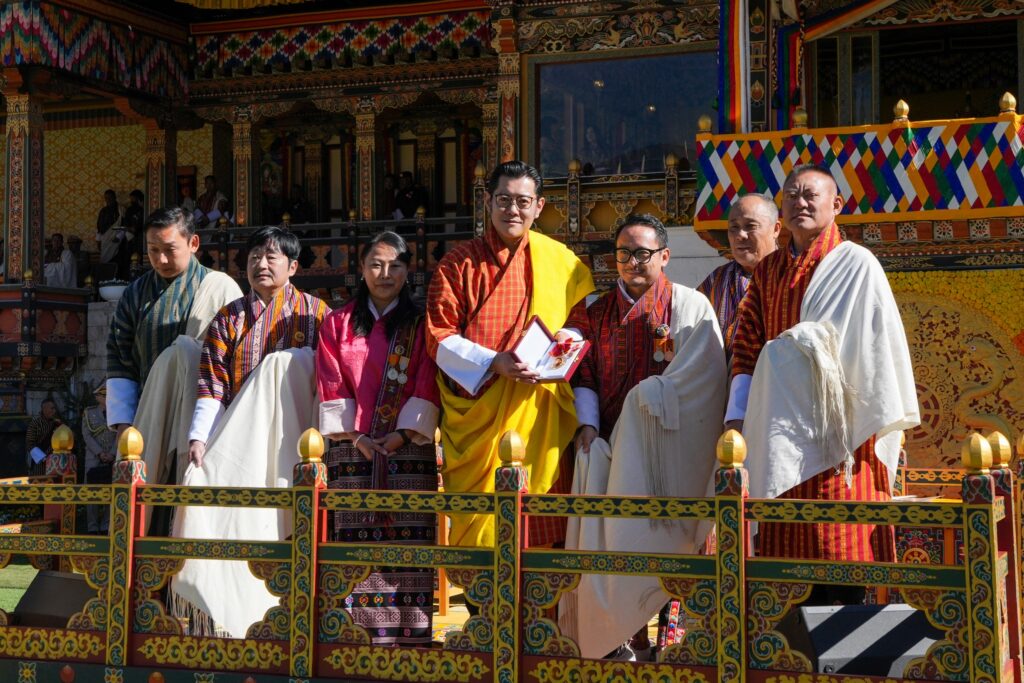🎖️ Bhutan’s Tourism Industry was honored with Kings Recognition 🎖️

Celebrating 50 Years of Sustainable Tourism National Day 117 receiveing award led by Director of Tourism, MoICE In a momentous occasion coinciding with the 117th National Day, His Majesty the King conferred the prestigious Druk Thuksey (Heart Son of Bhutan) Medal upon Bhutan’s tourism industry. This extraordinary honor recognizes the sector’s immense contributions to the […]
Chimi Lhakhang
The Secret to Fertility and Blessings: Discovering Chimi Lhakhang, the Enchanting Temple in Punakha, Bhutan Introduction to Chimi Lhakhang, the Temple of Fertility Nestled in the breathtaking landscapes of Punakha, Bhutan, lies a hidden gem known as Chimi Lhakhang. This enchanting temple holds a mystical allure that has captivated the hearts and minds of countless […]
Trashiyangtse Dzong
Introduction to Trashiyangtse Dzong Trashiyangtse Dzong, a historic fortress in Eastern Bhutan, holds immense cultural significance for the people of Bhutan. Located in the Trashiyangtse district, this magnificent structure stands as a testament to the country’s rich heritage and traditions. Trashiyangtse Dzong, also known simply as Trashiyangtse, is not only a physical embodiment of Bhutan’s […]
Art of Thagzo Weaving
Preserving Bhutan’s Rich Cultural Heritage: Timeless Art of Thagzo Weaving Bhutan, a small landlocked country nestled in the eastern Himalayas, is renowned for its rich cultural heritage. With a history deeply rooted in Buddhist traditions, Bhutan has managed to preserve its unique cultural identity over the centuries. The country’s commitment to preserving its traditional arts […]
Language Diversity in Bhutan
Bhutanese linguistics Bhutan, known as the Land of the Thunder Dragon, is a small Himalayan kingdom nestled between India and China. It is a country rich in cultural heritage, and one aspect that stands out is its diverse linguistic landscape. Bhutanese linguistics is a fascinating field that explores the origins, characteristics, and preservation of the […]
Hot Stone Bath for Ultimate Relaxation and Wellness
Bhutan’s ancient therapy – The Hot Stone Bath Bhutan, a landlocked country nestled in the Eastern Himalayas, is known for its rich cultural heritage and ancient traditions. Among these traditions, the Hot Stone Bath stands out as a unique and rejuvenating therapy that has been practiced for centuries. This therapeutic experience combines the healing properties […]
Dzongs of Bhutan
Cultural Landmarks and Symbolic Fortresses – The Dzongs of Bhutan Nestled in the breathtaking landscapes of Bhutan, the Dzongs stand tall as guardians of the country’s rich cultural heritage. These magnificent fortresses, with their unique architecture and symbolic significance, have become iconic cultural landmarks of Bhutan. As a traveler exploring this enchanting land, it is […]
Must-Visit Attractions in Tsirang
Bhutan, a small landlocked country nestled in the Himalayas, is a hidden gem of untouched beauty. Known for its pristine landscapes, vibrant culture, and spiritual heritage, Bhutan mesmerizes visitors with its unspoiled charm. One of the most captivating regions in Bhutan is Tsirang, a district located in the southern part of the country. Tsirang offers […]
Tales of the Bumdra Trek
Exploring the Heart of the Himalayas: Incredible Tales of the Bumdra Trek The Bumdra Trek, nestled in the heart of the Himalayas, is an extraordinary adventure that promises breathtaking views and unforgettable experiences. This 7-day trek takes you through lush forests, pristine landscapes, and ancient monasteries, offering a unique glimpse into the untouched beauty […]
Bhutan’s Sustainable Tourism
Bhutan’s Sustainable Tourism: A Journey into Eco-Friendly Initiatives Bhutan, known as the “Land of the Thunder Dragon,” is a small Himalayan kingdom nestled between India and China. With its breathtaking landscapes, rich cultural heritage, and commitment to sustainability, Bhutan has emerged as a model for sustainable tourism. In this article, we will delve into Bhutan’s […]
